What is a SWOT analysis?
A SWOT analysis is a technique used to determine and define your Strengths, Weaknesses, Opportunities, and Threats – SWOT. SWOT analyses can be applied to an entire company or organization, or individual projects within a single department. Most commonly, SWOT analyses are used at the organizational level to determine how closely a business is aligned with its growth trajectories and success benchmarks, but they can also be used to ascertain how well a particular project – such as an online advertising campaign – is performing according to initial projections. Whatever you choose to call them, SWOT analyses are often presented as a grid-like matrix with four distinct quadrants – one representing each individual element. This presentation offers several benefits, such as identifying which elements are internal versus external, and displaying a wide range of data in an easy-to-read, predominantly visual format, like these SWOT templates. ? Want this info to go? Download the guide >> How to Do a SWOT Analysis (With Examples & Reusable Template)Breaking down the SWOT analysis definition
We know that SWOT stands for Strengths, Weaknesses, Opportunities, and Threats – but what does each of these elements mean? Let’s take a look at each element individually.Strengths
The first element of a SWOT analysis is Strengths.- Things your company does well
- Qualities that separate you from your competitors
- Internal resources such as skilled, knowledgeable staff
- Tangible assets such as intellectual property, capital, proprietary technologies, etc.
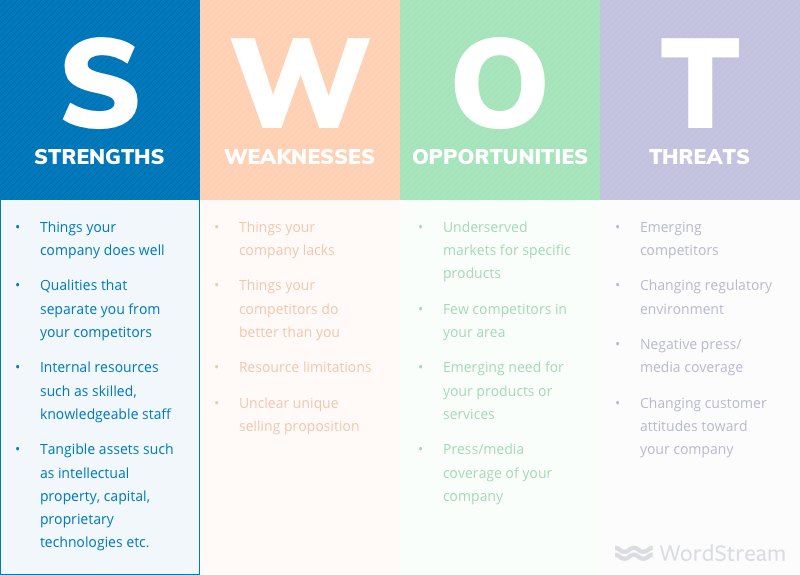 As you’ve probably guessed, this element addresses things that your company or project does especially well. This could be something intangible, such as your company’s brand attributes, or something more easily defined such as the unique selling proposition of a particular product line. It could also be your people, your literal human resources: strong leadership, or a great engineering team.
As you’ve probably guessed, this element addresses things that your company or project does especially well. This could be something intangible, such as your company’s brand attributes, or something more easily defined such as the unique selling proposition of a particular product line. It could also be your people, your literal human resources: strong leadership, or a great engineering team.
Weaknesses
Once you’ve figured out your strengths, it’s time to turn that critical self-awareness on your weaknesses.- Things your company lacks
- Things your competitors do better than you
- Resource limitations
- Unclear unique selling proposition
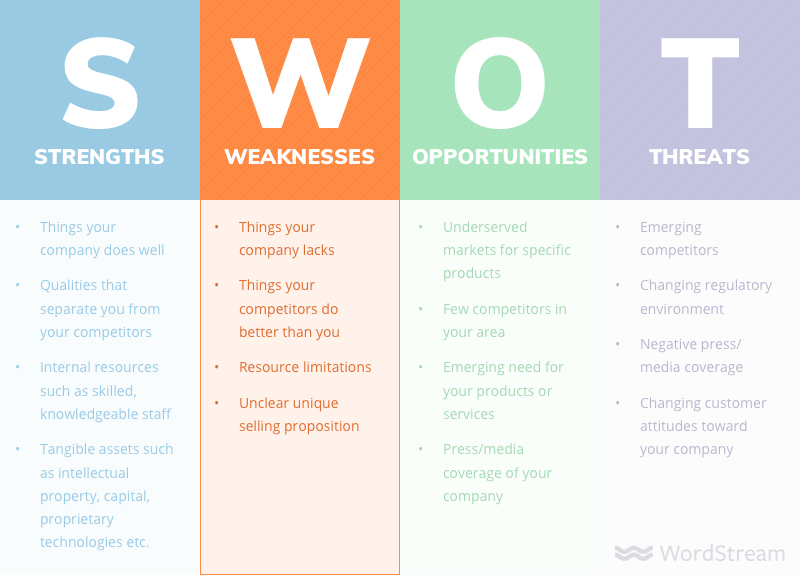 What’s holding your business or project back? This element can include organizational challenges like a shortage of skilled people and financial or budgetary limitations.
This element of a SWOT analysis may also include weaknesses in relation to other companies in your industry, such as the lack of a clearly defined USP in a crowded market.
What’s holding your business or project back? This element can include organizational challenges like a shortage of skilled people and financial or budgetary limitations.
This element of a SWOT analysis may also include weaknesses in relation to other companies in your industry, such as the lack of a clearly defined USP in a crowded market.
Opportunities
Next up is Opportunities.- Underserved markets for specific products
- Few competitors in your area
- Emerging needs for your products or services
- Press/media coverage of your company
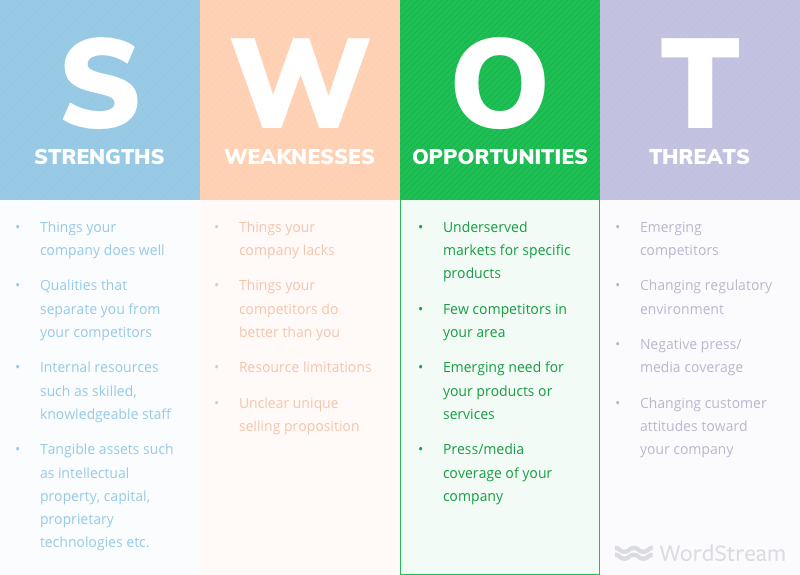 Can’t keep up with the volume of leads being generated by your marketing team? That’s an opportunity. Is your company developing an innovative new idea that will open up new markets or demographics? That’s another opportunity.
In short, this element of a SWOT analysis covers everything you could do to improve sales, grow as a company, or advance your organization’s mission.
Can’t keep up with the volume of leads being generated by your marketing team? That’s an opportunity. Is your company developing an innovative new idea that will open up new markets or demographics? That’s another opportunity.
In short, this element of a SWOT analysis covers everything you could do to improve sales, grow as a company, or advance your organization’s mission.
Threats
The final element of a SWOT analysis is Threats – everything that poses a risk to either your company itself or its likelihood of success or growth.- Emerging competitors
- Changing regulatory environment
- Negative press/media coverage
- Changing customer attitudes toward your company
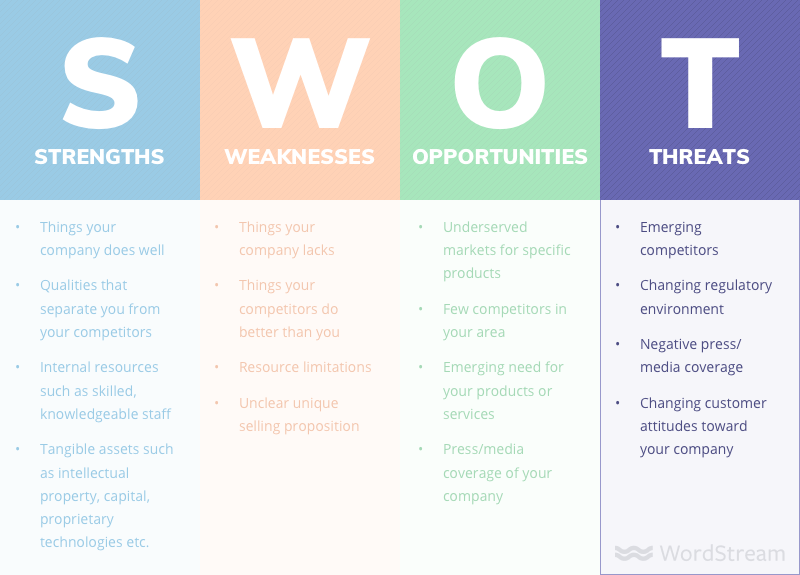 This could include things like emerging competitors, changes in regulatory law, financial risks, and virtually everything else that could potentially jeopardize the future of your company or project.
? Free Guide >> The 30 Best Ways to Promote Your Business
This could include things like emerging competitors, changes in regulatory law, financial risks, and virtually everything else that could potentially jeopardize the future of your company or project.
? Free Guide >> The 30 Best Ways to Promote Your Business
SWOT analysis internal and external factors
The four elements above are common to all SWOT analyses. However, many companies further compartmentalize these elements into two distinct subgroups: Internal and External.Internal factors
Typically, Strengths and Weaknesses are considered internal factors, in that they are the result of organizational decisions under the control of your company or team. A high churn rate, for example, would be categorized as a weakness, but improving a high churn rate is still within your control, making it an internal factor.External factors
Similarly, emerging competitors would be categorized as a threat in a SWOT analysis, but since there’s very little you can do about this, this makes it an external factor. This is why you may have seen SWOT analyses referred to as Internal-External Analyses or IE matrices.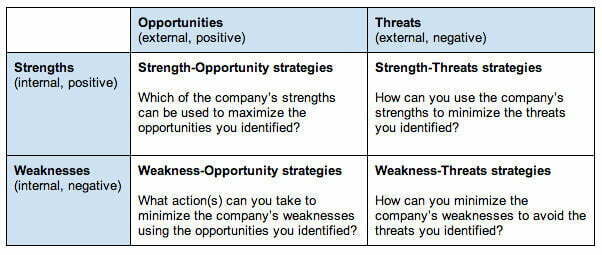
Image via Bplans
Subcategorizing your four primary elements into Internal and External factors isn’t necessarily critical to the success of your SWOT analysis, but it can be helpful in determining your next move or evaluating the degree of control you have over a given problem or opportunity. Now that we know what each of the elements of a SWOT analysis means, let’s take a look at how to go about creating and conducting a SWOT analysis.